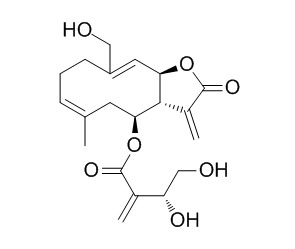Cnicin
Cnicin has anti-inflammatory, antibiotic, antibacterial and cytotoxic activities. It blocks the water uptake by roots inhibiting subsequent seedling growth but has no effect during germination.
Inquire / Order:
manager@chemfaces.com
Technical Inquiries:
service@chemfaces.com
Tel:
+86-27-84237783
Fax:
+86-27-84254680
Address:
1 Building, No. 83, CheCheng Rd., Wuhan Economic and Technological Development Zone, Wuhan, Hubei 430056, PRC
Providing storage is as stated on the product vial and the vial is kept tightly sealed, the product can be stored for up to
24 months(2-8C).
Wherever possible, you should prepare and use solutions on the same day. However, if you need to make up stock solutions in advance, we recommend that you store the solution as aliquots in tightly sealed vials at -20C. Generally, these will be useable for up to two weeks. Before use, and prior to opening the vial we recommend that you allow your product to equilibrate to room temperature for at least 1 hour.
Need more advice on solubility, usage and handling? Please email to: service@chemfaces.com
The packaging of the product may have turned upside down during transportation, resulting in the natural compounds adhering to the neck or cap of the vial. take the vial out of its packaging and gently shake to let the compounds fall to the bottom of the vial. for liquid products, centrifuge at 200-500 RPM to gather the liquid at the bottom of the vial. try to avoid loss or contamination during handling.
Int J Biol Macromol.2025, 292:139225.
J Nat Med.2017, 71(2):380-388
Life (Basel).2023, 13(2):457.
Mol Biol Rep.2022, doi: 10.1007
J Agric Food Chem.2021, 69(46):14037-14047.
Chem Biol Interact.2023, 378:110487.
Toxins (Basel).2019, 11(10):E575
Molecules.2021, 26(3):695.
Molecules.2020, 25(21):5091.
Heliyon.2022, e12337.
Related and Featured Products
Journal of Chemical Ecology, 01 Apr 1994, 20(4):929-942.
Influence of cnicin, a sesquiterpene lactone ofCentaurea maculosa (Asteraceae), on specialist and generalist insect herbivores.[Reference:
WebLink]
The sesquiterpene lactone Cnicin was extracted fromCentaurea maculosa andCentaurea vallesiaca. We examined its effects on the ovipositional response and larval development of generalist and specialist insect herbivores associated withC. maculosa.
METHODS AND RESULTS:
For the oviposition trials, three plant species (C. maculosa, Achillea millefolium, andCichorium intybus), half of which were sprayed with 3% of Cnicin, were exposed to the specialist mothsStenodes straminea, Agapeta zoegana, andPterolonche inspersa in field cages. All three species significantly preferredC. maculosa to other plants andP. inspersa significantly preferred Cnicin-sprayed plants to untreated plants for oviposition. Tested over all species, Cnicin significantly increased the number of eggs laid on a given plant. A larval diet test examined the toxicity of Cnicin for larvae of the generalist noctuid mothSpodoptera littoralis. Cnicin concentrations of 3% and 6% were lethal and 1% and 0.5% seriously inhibited growth and development. The larvae of theC. maculosa specialistStenodes straminea survived at 6% Cnicin, but none of the pupae hatched.Agapeta zoegana was able to survive at 1% and 3% Cnicin. Both specialists had difficulties with the artificial diet, but weight increase and survival was not further reduced when Cnicin was present compared with on the control diet.
CONCLUSIONS:
In conclusion, Cnicin influenced host recognition by the specialist species, and larvae of the generalist did not survive on natural levels of Cnicin. Growth and survival of the specialist were not influenced by Cnicin but were considerably hampered on artificial diet.
Pharmaceutical Biology, 2010,49(8):840-849.
Secondary metabolites of Centaurea calolepis and evaluation of cnicin for anti-inflammatory, antioxidant, and cytotoxic activities.[Reference:
WebLink]
Secondary metabolite determination, isolation and structure elucidation of pure compounds were performed on C. calolepis. Cnicin, which is the main component of several Centaurea species, was tested for its in vitro anti-inflammatory, antioxidant and cytotoxic activities.
METHODS AND RESULTS:
Chloroform and methanol extracts of the aerial parts of C. calolepis were subjected to isolation process using column chromatography. The structures of the compounds were characterized by 1D- and 2D-NMR experiments. Thin–layer chromatography and high performance liquid chromatography were used in determination of phenolics. Cnicin was subjected to a panel of cellular assays to test for inhibition of nuclear factor κB (NF-κB), inducible nitric oxide synthase (iNOS), reactive oxygen species and cytotoxicity. Cnicin, lucenin-2, schaftoside and 3-O-feruloylquinic acid were isolated from C. calolepis extracts. Vicenin-2, vitexin, isovitexin, homoorientin, rutin, orientin, luteolin-7-O-glycoside and chlorogenic acid were determined in fractions. Cnicin showed inhibition of NF-κB and inhibition of iNOS activity with IC50 Values of 1.8 and 6.5 µM, respectively. Cytotoxic activity of Cnicin was observed toward pig kidney epithelial (LLC-PK11), human malignant melanoma (SK-MEL) and human ductal carcinoma (BT-549) cells with IC50 values of 23.3, 14.0 and 18.3 µM, respectively.
CONCLUSIONS:
This is the first detailed report of secondary metabolites of C. calolepis. Evaluation of biological activity of Cnicin establishes the potential of this compound as an anti-inflammatory and cytotoxic agent.
Thermochimica acta, 2007, 458(1):84-87.
A calorimetric study of the allelopathic effect of cnicin isolated from Centaurea diffusa Lam. on the germination of soybean (Glicine max) and radish (Raphanus sativus).[Reference:
WebLink]
METHODS AND RESULTS:
This work concerns the application of isothermal calorimetry to measure the effect of ‘Cnicin’ on the germination of the soybean (Glycine max (L.) Merr., cv. A7636 RG) and the radish (Raphanus sativus L., cv. Sparkler). The sesquiterpenelactone, Cnicin was isolated from a highly invasive plant, the diffuse knapweed Centaurea diffusa Lam. Calorimetric experiments were performed with seeds on wetted filter paper disks or in agar, both containing varying concentrations of Cnicin.
CONCLUSIONS:
Results indicate that this substance blocks the water uptake by roots inhibiting subsequent seedling growth but has no effect during germination.
Planta Medica, 2003, 69(3):277-281.
Antibacterial evaluation of cnicin and some natural and semisynthetic analogues.[Reference:
WebLink]
METHODS AND RESULTS:
Some ester derivatives of salonitenolide have been prepared from Cnicin, a germacranolide sesquiterpenoid. The compounds were tested for their antibacterial activity. The 8,15-diesters showed a good activity, comparable with that of Cnicin.
CONCLUSIONS:
The 15-monoester compounds were not very active showing that esterification at the C-8 position is an important structural feature for antibacterial properties.



